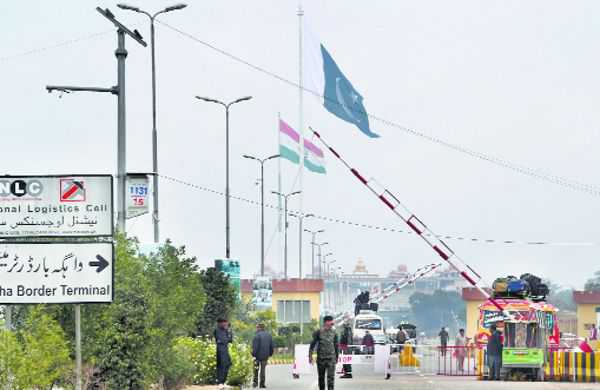India needs an implementable, sustainable, and above all, affordable non-military war strategy against Pakistan. The push for war goes against India’s painfully constructed image of a pacifist and defensive defence policy. Recent initiatives such as the revocation of the MFN status and the proposal to divert waters indicate that we do have tools to launch a ‘war by other means’ and test Pakistan’s resilience

Bhartendu Kumar Singh
Indian Defence Accounts Service
AFTER the Pulwama attack, India’s hotchpotch national security discourse has drifted towards talk of war, hitherto a declining trend in international relations. There has been rising demand for waging a ‘war against Pakistan’. Buoyed by the Balakot air strike, many Indians assume that a frontal onslaught on Pakistan would bring it to its knees. They blissfully forget that Pakistan is a middle power having comparable resources and would deny an outright victory to India. India needs an appropriate, implementable, sustainable, and above all, affordable non-military war strategy against its neighbour.
Before 1971, Pakistan had nearly one-third to one-fourth of India’s resources and was a ‘big’ State. Probably, that is why the wars of 1948 and 1965 did not lead to an outright victory for India. While Pakistan’s capabilities to wage wars against India decreased after the 1971 dismemberment, it still has roughly one-fourth to one-fifth of all kinds of resources that India has. According to globalfire.com, a website on comparative military power, while India is four th on the ‘most powerful’ military powers’ list, Pakistan is 17th — ahead of North Korea, Australia, Taiwan and Saudi Arabia. Further, the asymmetry is not well defined (India’s military power index is 0.417, Pakistan’s 0.368). Probably, that explains Pakistan’s capacity to provoke India every now and then.
India also does not have the luxury of 1971-type diplomatic treaties and assurances, despite its rising profile in international relations. On the contrary, Pakistan has a tacit understanding with China, convertible into a military understanding or agreement, leading to a formidable balance of military alliance against India. Chinese investments into Pakistan, best reflected in the China Pakistan Economic Corridor (CPEC), make Beijing very attentive to Pakistan’s security calculus. The nuclear factor also brings a semblance of power parity between India and Pakistan that could make wars mutually damaging.
Finally, despite a seven-decade-old war history with Pakistan, we are yet to institutionalise studies like the Correlates of War (CoW) Project launched in the US to study the factors that lead to war. As such, not only are we indifferent to the probability of war between the two countries, but also clueless about victory in hypothetical wars with Pakistan due to an absence of proliferated lab-based simulation exercises. The Indian armed forces do conduct war exercises, either on their own or in partnership with foreign militaries. However, derivative lessons from such exercises are yet to be studied and tested in the academic sense.
India has a three-fold security dilemma on the Pakistan front. First, Pakistan is waging a proxy war with minimal financial and military investments but causing maximum impact. Islamabad has spent barely a fraction in provoking India compared to the Indian response that has come at a heavy cost. New Delhi is compelled to deploy a significant proportion of its armed forces in J&K to rebut Pakistan-sponsored terror activities. Second, a full-fledged war is ruled out since there would be a stalemate (unless India goes the whole hog), apart from being a costly proposition. Moreover, the push for war goes against India’s painfully constructed image of a pacifist and defensive defence policy. Third, India is also in the midst of building a comprehensive national power (CNP) focusing on developmental aspects of security. At least in the foreseeable future, India may not prefer to be distracted by war-like activities.
It emerges, therefore, that India has to explore non-military and affordable options in dealing with Pakistan. Perhaps the most desirable choice would have been a smaller Pakistan with reduced propensity to wage proxy wars against India. If only Pakistan were of the size of, say Iran, it would have been looking up to India (for security assurances) than indulging in provocative games. A smaller Pakistan would have been no ‘flag-bearer’ for secessionist forces in Jammu and Kashmir. While another division of Pakistan may not happen in the near future, the dominant position of Punjab is being resisted by other smaller provinces, most notably Sindh and Balochistan. This internal contradiction needs to be championed on informal platforms.
Another option could be to expose Pakistan’s ‘fictitious’ identity, mobilised largely on anti-India semantics. Pakistan has failed to progress as a civil society, with insignificant gender and minority rights; the military will reigns supreme and democracy is in name only. Even in Pakistan-occupied Kashmir (PoK), basic civic rights do not exist and the region remains impoverished. Pakistan bartered away a portion of PoK in the Gilgit region to China in 1963. Pakistan is increasingly known as a rogue State promoting terrorist forces within and around it. These representative constructs need to be exposed through the exclusion of Pakistan from all possible forums. For example, in recent years, India has successfully marginalised Pakistan within the South Asian fraternity, best evident in SAARC. It would be prudent to move ahead on a SAARC vision minus Pakistan. That would be a loss of face for Pakistan since it cannot assimilate in the alternative West Asian or Arab imagination.
The military option against Pakistan would be costly and should be exercised as the last resort. Recent initiatives like the revocation of the MFN status, proposal to divert waters etc. indicate that we do have tools to launch a ‘war by other means’ and test Pakistan’s resilience. Historically, great powers have successfully used it. We certainly need to proliferate our non-military options.
Views are personal
